Teramachy
Teramachy is the child of Metamachy with 12 rows and Terachess with 16 columns. The design of this game started in 2019 and was finally completed in 2020.
This is a chess variant with 23 different pieces on a 16x12 square board. There are the familiar 6, the 6 encountered in Metamachy, 5 coming from Zanzibar and the 6 FIDE compound pieces.
There are 192 squares and 96 pieces in total.
|
Caution: this chess variant needs more play testing. It may evolve yet |

The board has 16 x 12 checkered squares with a white one at the right end of each player.
There are 48 pieces per side:
- 1 King, 1 Amazon, 1 Queen, 1 Marshal, 1 Cardinal, 1 Admiral, 1 Missionary, 1 Centaur, 1 Lion, 1 Eagle, 1 Rhinoceros, 1 Buffalo
- 2 Elephants, 2 Rooks, 2 Knights, 2 Bishops, 2 War Machines, 2 Princes, 2 Cannons, 2 Camels, 2 Giraffes, 2 Crocodiles
- 16 Pawns on 3rd row.
Moves And Captures
Most of the pieces moves as they do at Metamachy or Zanzibar.
- King: as in Metamachy, i.e. moves as in usual Chess with no castling but initial King's jump.
- Queen: exactly as in usual Chess.
- Bishop: exactly as in usual Chess.
- Knight: as in usual Chess.
- Rook: exactly as in usual Chess, except there is no castling at Teramachy.
-
Pawn: as in Metamachy, not as is usual Chess. It can move straight forward one or two square from any position on the board, without capturing. It captures one square diagonally forward. When he reaches the last row it promotes to one of the following major pieces: Amazon, Lion, Eagle, Rhinoceros, Buffalo.

-
Prince: as in Metamachy. He moves and captures one square in any direction like a King, but without being hindered by check. Like the Pawn, he can also move without capturing to the second square straight ahead from any position on the board. When he reaches the last row it promotes to one of the major pieces like the Pawn does.

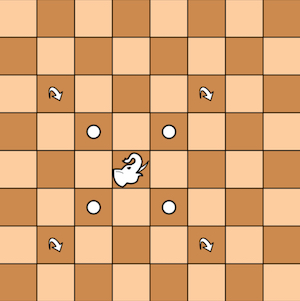
-
Machine: it is an orthogonal counterpart of the Elephant as it moves one or two squares on the rows or the columns. When a Machine moves two squares, no matter what intermediate squares contain. Therefore, it combines the moves of old Dabbaba and Wazir found in ancient Muslim Chess variants. As in Zanzibar.

-
Marshal:it combines the move of Rook and Knight.

-
Cardinal: it combines the move of Bishop and Knight.

-
Lion: exactly as in Metamachy. It moves as a King (a single step move in any direction), or may jump to a position two squares away, jumping in any orthogonal or diagonal direction, or jumping as a Knight.
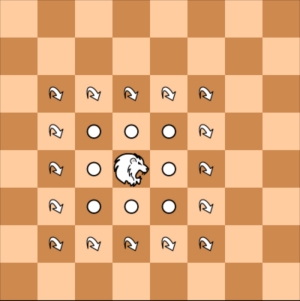
-
Camel: as in Metamachy. It jumps to the opposite square of a 2x4 rectangle, like an extended Knight. No matter what intermediate squares contain. It is also described as a (3,1) leaper. Note that it always stays on the same color of square.
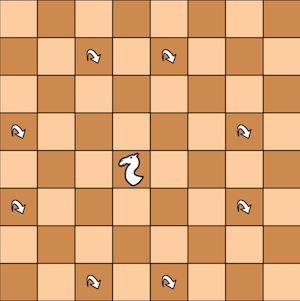
-
Giraffe: as in Zanzibar. It jumps to the opposite square of a 3x4 rectangle, like an extended Knight. No matter what intermediate squares contain. It is also described as a (3,2) leaper. Note that it always changes the same color of its square. Under the name of Zebra, it is also a fairy piece used by problemists for compositions.

-
Cannon:exactly as in in Xiangqi. Also in Shako and Metamachy. It moves without taking like a Rook, but it takes by going in a straight horizontal and vertical line and jumping over exactly one piece. When a Cannon takes a piece, there must be exactly one piece between the original and final square of the Cannon's move - this piece may be of either color.
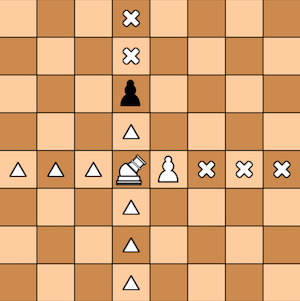
-
Crocodile:as in Zanzibar. It is the diagonal counterpart of the Chinese Cannon. It moves like a Bishop and needs an intermediate piece between itself and its victim to capture it. The Crocodile jumps the intermediate and takes the victim on its square. The intermediate is left unaffected. It is also known as Vao by problemists.

-
Buffalo:as in Zanzibar. It combines the leaps of the Knight (2,1 leaper), the Camel (3,1 leaper) and the Giraffe (3,2 leaper).
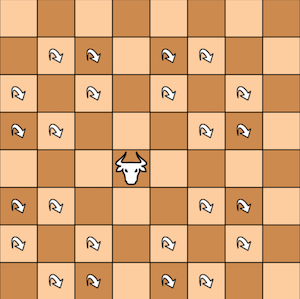
-
Eagle:as in Metamachy. It moves one square diagonally and then, slides away of an indefinite number of squares vertically or horizontally. It is authorized to go only one square diagonal. It can not jump and the unobstructed path must start with the diagonal movement.

-
Rhinoceros: as in Zanzibar. It moves one square vertically or horizontally and then, slides away of an indefinite number of squares diagonally. It is authorized to go only one square in line or column. It can not jump and the unobstructed path must start with the orthogonal movement. It is a counterpart of the Eagle.

-
Centaur: it is another compound piece that moves as a Knight or a non-royal King.

-
Admiral: it is another compound piece that moves as a Rook or a non-royal King. That means that it is a Rook that can also step one space diagonally. It corresponds to the Dragon King that is found in Shogi.

-
Missionary: it is another compound piece that moves as a Bishop or a non-royal King. That means that it is a Bishop that can also step one space orthogonally. It corresponds to the Dragon Horse that is found in Shogi.

-
Amazon: it combines the move of Queen and Knight. An old idea, used by Russians instead of the Queen in the 18th century.

-
Pawn and Prince Promotion: A Pawn or a Prince reaching the last rank of the board is immediately replaced by an Amazon, a Lion, an Eagle, a Rhinoceros or a Buffalo. Promotion to any other type of piece is not allowed. It is permitted to promote a Pawn or Prince to a type of piece already present on the same side; however; it is considered “good etiquette” to avoid choosing a piece which is not captured yet, if possible.
- En Passant capture: Any time a Pawn or Prince takes a double step and passes through the capture square of an opposing Pawn, that Pawn may capture the Pawn or Prince as if it had only moved one square. This en passant capture must be made in the immediate move following the double step. Only a Pawn may capture en passant; the Prince does not have this option.
-
End Of Game: The end-of-game rules, checkmate, stalemate, etc., are identical to standard chess.
Pieces Value
Estimated average pieces value, normalized to 5 for the Rook :
Pawn: 1, Giraffe: 2, Camel: 2, Elephant: 2, Knight: 2, Machine: 2.5, Prince: 3, Crocodile: 3, Bishop: 3.5, Cannon: 4, Missionary: 4.5, Centaur: 4.5, Rook: 5, Cardinal: 5.5, Rhinoceros: 6, Buffalo: 6, Admiral: 6, Lion: 6.5, Marshal: 7, Queen: 8, Eagle: 8.5, Amazon:10
These values are just given for a very rough estimate. A lot of players would disagree and give less or more points to several piece. Never mind, make your own scale.
Find Teramachy in the Chess Variant Pages
There is a preset to play it there.




